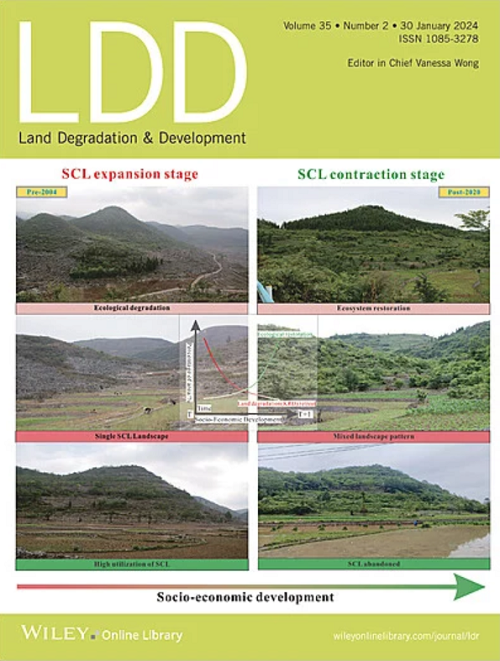典型干旱区生态脆弱性的主要驱动因素是自然因素还是人为因素?从进化过程框架的分析
IF 3.6
2区 农林科学
Q2 ENVIRONMENTAL SCIENCES
引用次数: 0
摘要
生态脆弱性作为区域可持续发展的关键指标,深入研究生态脆弱性有助于实现精准生态保护。然而,区域环境的复杂性导致电动汽车的驱动机制难以明确,特别是在具有特殊自然气候的地区。本文建立了典型干旱区自然-社会-经济-污染-环境综合指数体系和分析框架,揭示了典型干旱区生态环境的时空异质性及其驱动因素。基于结构方程模型,阐明了主导因素的空间驱动机制。最后,利用CA‐Markov模型预测了2035年不同情景下EV的空间异质性。结果表明:①2000-2020年,生态脆弱性等级呈东南—西北上升趋势,9.6%的地区由高脆弱性向低脆弱性过渡;(2)降水、农民收入和归一化植被指数(NDVI) 3个因子是导致研究区EV的最重要因子。(3) 2035年可持续发展情景对生态保护和人与自然和谐的支撑作用增强。该研究可定量识别生态系统空间异质性规律及其影响因素,为自然环境复杂、人类活动频繁地区生态系统演化提供可行性思路。本文章由计算机程序翻译,如有差异,请以英文原文为准。
Are the Main Drivers of Ecological Vulnerability in Typical Arid Zones Natural or Anthropogenic? An Analysis From an Evolutionary Process Framework
As a key indicator of regional sustainable development, in‐depth study of ecological vulnerability (EV) is conducive to the realization of precise ecological protection. However, the complexity of the regional environment causes the driving mechanism of EV to be difficult to clarify, particularly for areas with special natural climates. This study developed a comprehensive natural‐social‐economic‐pollution‐environmental (NSEPE) index system and analytical framework for typical arid areas, revealing EV's spatiotemporal heterogeneity and driving factors. Based on structural equation modeling, the spatial driving mechanism of the dominant factors was clarified. Finally, the spatial heterogeneity of EV in 2035 under different scenarios was predicted using the CA‐Markov model. The results indicated that: (1) Ecological vulnerability grades exhibited a southeast‐northwest increasing trend (2000–2020), with 9.6% areas transitioning from high to low vulnerability. (2) The three factors of precipitation, farmers' income, and Normalized Difference Vegetation Index (NDVI) were the most important factors causing EV in the study area. (3) Sustainable development scenarios better support ecological protection and human‐nature harmony by predicting for 2035. This study can quantitatively identify the law of spatial heterogeneity of EV and its influencing factors, and also provides a feasible idea for EV evolution in areas with complex natural environments and frequent human activities.
求助全文
通过发布文献求助,成功后即可免费获取论文全文。
去求助
来源期刊

Land Degradation & Development
农林科学-环境科学
CiteScore
7.70
自引率
8.50%
发文量
379
审稿时长
5.5 months
期刊介绍:
Land Degradation & Development is an international journal which seeks to promote rational study of the recognition, monitoring, control and rehabilitation of degradation in terrestrial environments. The journal focuses on:
- what land degradation is;
- what causes land degradation;
- the impacts of land degradation
- the scale of land degradation;
- the history, current status or future trends of land degradation;
- avoidance, mitigation and control of land degradation;
- remedial actions to rehabilitate or restore degraded land;
- sustainable land management.
 求助内容:
求助内容: 应助结果提醒方式:
应助结果提醒方式:


